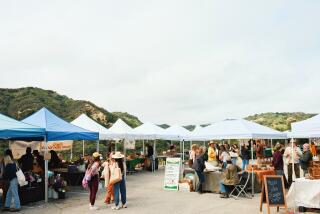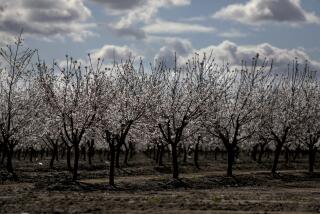Cotton’s sudden boom raises specter of a bust

See full story
King Cotton is back.
More than a decade after the state’s “white gold” crop started losing its luster, booming commodity prices have farmers cashing in on growing export demands — and have turned great swaths of Central California a snowy white during harvest season.
Cotton-picking machines chug across old vegetable fields, former vineyards and land long fallow. Stacks of Pima cotton, as long as a semitrailer, stand row upon row as far as the eye can see, waiting to be shipped to mills and turned into Jockey underwear, Fieldcrest towels or L.L. Bean shirts.
The bits of white debris dusting the sky and lying on the side of the road, lost on the drive from field to port, hardly seem a blight. Instead, in towns such as Huron, Lemoore and Firebaugh where joblessness has soared, they are signs of hope returned.
Cotton gins at once-shuttered plants rumbled back to life. Machine shops are recruiting mechanics who understand the underpinnings of Boll Buggys and cotton strippers. Seed salesmen are scrambling to keep up with orders from farmers eager for spring to come to their gold-green expanse.
“It feels so good to think that things could be good again,” said Kathy Neves, office manager of Huron Ginning Co., which rehired 30 workers and turned its machines back on this fall.
Although California’s current production numbers are a pittance compared with the 1990s, when more than 1 million acres of cotton flourished, farmers are ramping up — particularly in the San Joaquin Valley, historically the heart of the state’s cotton industry.
Growers were expected to plant a total of 309,000 acres of Pima and upland cotton this year, up from 201,000 last year, according to the U.S. Department of Agriculture’s Economic Research Service.
A similar movement is happening in the South, Southwest and elsewhere in rural America. Nationwide, the total acreage of cotton planted grew nearly 21% this year to 11.04 million acres. The amount of cotton harvested? It jumped 51%.
The increases are being driven in part by short supplies caused by poor weather in major producing regions overseas and robust demand from emerging markets such as China and India. Prices surged in the summer and fall as the USDA forecast that cotton stockpiles in China — the world’s biggest user and importer — would be the tightest in more than a decade.
Investors and speculators, already in the rising commodity markets as a hedge against inflation and the risk of further devaluation of the dollar and other paper currencies, have raced to embrace cotton.
It’s a radical shift from the depths of the recession just two years ago, when the textile industry collapsed as consumers cut back their spending on luxury goods. It particularly hurt California farmers, who produce 90% of the country’s Pima cotton crop used to make higher-end textiles.
In November 2008, benchmark cotton futures plunged to 37 cents a pound, the lowest since 2002. Now, the price has quadrupled, closing at $1.50 a pound as of Friday after rising as high as $1.57 last month.
“The pendulum for cotton tends to swing very widely, but I’ve never seen anything like this,” said Sharon C. Johnson, a senior cotton analyst at Penson Futures, a brokerage firm based in Chicago. “I don’t think it’s going to change any time soon. It’s going to take two years of strong production to have things level out, meaning it will take that long before world stockpiles — and therefore prices — return to a semi-normal level.”
The effects are rippling from financial trading floors to the sales floor of Thomason Tractor Co. in Firebaugh, 221 miles northwest of Los Angeles. Business is brisk. It’s sold five harvesters in the last month, pulling in about $2.5 million in sales. Steve Malanca, the general manager, hired two mechanics to handle the growing stream of service calls for cotton machinery.
One local farmer, who had sworn off the crop years ago, needed someone to reassemble his cotton planter, Malanca said. “There were parts lying in a shack, others stacked elsewhere outside. He said, ‘I need you to put it together. I gotta plant cotton in May.’ ”
This agricultural boon, however, is more than simply economic. It also has revived a piece of the region’s heritage.
Cotton came to California’s heartland more than a century ago, as waves of ambitious farmers and local rogues shaped the land with the plantation culture of the South. Even today, mint juleps remain a staple on some bar menus, and Corcoran — home to the Boswell cotton empire — celebrated the 50th anniversary of its cotton festival in October with a frog-jumping contest and floats in a parade through town.
“There’s an upbeat, positive attitude. It has caused the community to feel good about itself,” Corcoran Mayor Larry Hanshew said. “I’m just concerned about how long it will last.”
The price run-up isn’t good news for everyone: Analysts caution that starting next year, U.S. consumers will probably be paying more for their shirts, sheets and socks.
Gap Inc., J.C. Penney Co. and other retailers have warned that the rise in cotton prices means they may have to pay Chinese suppliers at least 20% more for clothing. How much of that cost will trickle down to the retail shelves is uncertain.
That question nags at Tony Azevedo, a stocky, fourth-generation cotton farmer in Stratford, a rural hamlet 190 miles northwest of Los Angeles. On a recent afternoon, he parked his pickup truck on a dirt road cutting across one of his fields and got out to check on the harvest. Half a dozen mechanized pickers rumbled in the distance. Three farmworkers used hand rakes to collect stray tufts along the road and tossed them into a bin, to be cleaned and sold.
Worry lines tugged at Azevedo’s weathered face. In the spring, his family plowed and planted 2,600 acres of Pima cotton. By fall, the crops were coming in and his cellphone rang with the sales calls from a local cotton cooperative: A Chinese firm bought some of his cotton at $1.55 a pound.
“I thought, ‘Wow, that’s great,’ ” recalled Azevedo, 37, whose family owns Stone Land Co.
The orders piled up. So did the sales price. $1.68 a pound. $1.86. $2. $2.10.
Autumn is usually a joyous season, the brimming loads a payoff for months of sweat. Azevedo has learned to treasure this moment — but not bank on it. Cotton prices boom and, just as fast, they bust. But not in three generations, he said, has it boomed this high or this fast.
“It’s not good. I don’t want a market that’s so high no one uses our product,” Azevedo said. “In this economy, will people pay $2, $3, more for a cotton shirt? Or will they buy clothes made with something else?”
The farmer reached down to pick up a stray clump of cotton and tossed it into the bin, then walked back to his truck. His phone buzzed. Azevedo read the text message and quietly groaned: Another order of cotton was sold to a customer in China — for $2.28 a pound.






